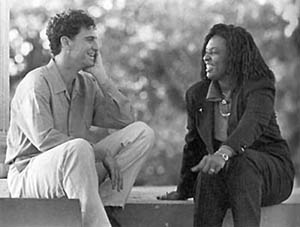One Small Step

 Edward Ball with his distant cousin Carolyn Smalls Goodson, a descendant of Ball slaves. |
In the course of his research, Ball attempted to calculate the number of descendants of Ball slaves living in the United States. A mathematically conservative estimate put the number at about 75,000 by the turn of the millenium; a more moderate guess would be about 100,000. The task of telling their stories —to say nothing of setting the stage for reconciliation between them and the Ball family— is staggeringly large, but still insignificant compared to the task of those who would ease the racial problems which still vex our country.
Slaves in the Family ends rather abruptly with the ceremony of supplication in Sierra Leone. Contrary to expectations, there is no concluding discussion of affirmative action, restitution, or other contemporary racial issues, which might naturally follow from the subject matter. And aside from providing some necessary historical background, Ball scrupulously avoids expanding the scope of the work beyond the lives of the families chronicled.
This omission seems deliberate. It is as though Ball recognizes that the racial gulf created by slavery is so great that an attempt by one man to heal it would take sheer hubris. It is all he can do just to address the legacy of his own family. As he says, "I'm trying to take care of my own business at the level of one person and one family... It has taken just about every ounce of my energy even to do that." A national conversation needs to ensue before a satisfactory account of slavery can emerge, along with the "context" and "consensus" necessary for true racial reconciliation.
In addition to being a work of history, Slaves in the Family is the first gesture in a rite of atonement. One can only hope that Ball's example will inspire others to someday complete it.








